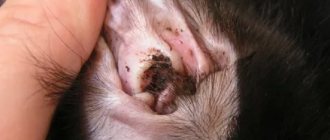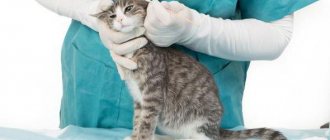How do ear diseases manifest?
It is not difficult to determine that a cat is experiencing discomfort - the owner just needs to take a closer look at the pet. If a cat constantly and restlessly shakes its head and tries to get rid of unpleasant sensations with its paws, this may indicate the development of a dangerous disease in its ears. In this case, as a result of a visual examination, you will reveal not only hyperemia (redness), but also an accumulation of wax, crusts and fluid in the ears.
Note! Normally, the color of your pet's inner ear should be soft pink. The surface is usually a little shiny and glossy, but does not release moisture. Minor accumulations of sulfur are acceptable. Moreover, their color can vary from light to dark brown. However, the main indicator is the smell. It shouldn't be harsh or unpleasant.
Parasites
It is no secret that cats are kept in different conditions at home. Some owners do not let them outside, others allow them to move freely. And those cats that are often outdoors are at risk of picking up ticks.
This is a dangerous, extremely unpleasant parasite that burrows into the surface of the ear and when a cat has spots on its ears, red spots appear. Because he constantly scratches his ears with his paws. In this case, a special medicine helps, which allows you to get rid of the parasite.
Ear mite
Otodectic mange (or ear mite, ear scabies) is a disease most often caused by superficial sarcoptic mites of the genus Otodectes cynotis. These small skin beetles parasitize the upper layers of the epidermis. Scabies mites are found in 85% of pets whose ears and ear canals are irritated.
Symptoms of otodectosis include:
- Severe itching, provoked by damage to surface tissue structures by waste products secreted by parasites;
- Swelling of tissues and their redness due to thinning of blood vessels and their overflow with blood;
- The appearance of discharge (exudate);
- The appearance of black plaque in both ears;
- Formation of dark brown scabs;
- A blockage occurs in the ear canal after too many scabs have accumulated. As a result, the pet begins to lose hearing;
- Putrid odor;
We recommend the article: Why does my cat have black plaque in his ears?
If you find not only red spots in the cat’s ear, but also all or some of the above manifestations, your ward should be immediately shown to a specialist. The fact is that an advanced case of otodectosis can lead to labyrinthitis (inflammation of the inner ear), and that, in turn, to pathological disorders in brain function, sepsis and death.
Infection of a healthy cat most often occurs after contact with a tick carrier. This may not necessarily be a direct impact - you can also acquire parasites through carriers, combs, slicker brushes and other items. Often people themselves bring ticks into the house. An uninvited “guest” can cling to clothes, hands and shoes, especially in the warm season, when the temperature is favorable for the life expectancy of the parasite. It is worth noting that young individuals under the age of 1 year are most susceptible to otodectosis.
Dermatitis
The cat's ears on the head turn red as a result of simple dermatitis, which occurs when the mechanical ones are damaged. When any scratches, burns, etc. appear. In this case, red spots are also noticed near the ears.
In fact, this is an elementary inflammation that is treated with the most common anti-dermatosis drugs. As you can see, a cat’s ears turn red for various reasons, but treatment is always necessary, since otherwise the disease will be neglected and lead to dire consequences.
Eczema
In eczema, red spots on a cat's ear are caused by water, a chemical, or a foreign object getting into the ear. Provocateurs are also:
- External irritants (chafing collar, contact with rough fabric, etc.);
- Allergic reactions of the immune system to individually intolerable components (for example, food);
- Fungi, bacteria, as well as fleas and other parasites;
- Irritating substances (shampoos, dyes, household chemicals, etc.);
- Seborrhea (dandruff);
- Chronic stress;
- Diseases of internal systems and organs (gastrointestinal tract, liver, kidneys, etc.);
- Hormonal disorders;
Eczema can be dry or weepy.
The first form is characterized by the absence of infection in the affected areas. The surface epithelium undergoes keratinization and becomes covered with dry scales and tubercles.
The second type is caused by fungi, viruses and bacteria of a pyogenic nature entering the body. With weeping eczema, the blistering rashes open on their own, and the tissues adjacent to the affected areas soften and constantly secrete exudate. Eczema becomes chronic 3-6 weeks after the onset of its development. It is characterized by absolute dryness of the skin and atrophy of the hair follicles.
We recommend the article: Albino cats: features of appearance, health and character
Ringworm.
A fungal disease (microsporia) that develops due to improper keeping of the pet, skin injuries and weakened immunity. The fungus is everywhere, danger lies in wait for a cat walking on the street, when interacting with stray pets, and you can also catch microsporia from rats and mice. Cats that live in the house can also become infected if the owner brings in street dirt on their shoes. An animal that has become infected with microsporia develops round-shaped, hairless spots. Depending on the duration of the disease, the skin may be affected in several areas, most often in the head, ears, paws and tail. Pustules and peeling of the skin may form there. Ringworm in cats is a rather complex disease that will take a long time to treat; it is selected by a doctor according to a certain scheme. A good solution would be to vaccinate your pet and not worry about possible infection.
Red spots in a cat's ear photo
Treatment
Treatment of ear diseases accompanied by brown discharge from the ear may include medications, physiotherapy, and sometimes surgical methods. It all depends on the root cause that caused the painful symptoms.
Drug treatment includes:
- Antibacterial agents. Prescribed for purulent types of otitis.
- Vasoconstrictor drops. Reduce swelling.
- Antimycotic agents. Effective against fungal infections.
- Antihistamines. Prescribed if there is swelling and itching of an allergic nature.
- Painkillers.
The following physiotherapeutic procedures help in the treatment of diseases:
- dry heat;
- electrophoresis;
- inhalation.
Hematoma
One form of blood blister may occur in your cat's ear. It appears between the layers of the ear when the animal begins to scratch the ear. Blood from damaged vessels forms clots, which are usually removed either through surgery or through gentle treatment with special ointments. The course of their application to the affected area is several weeks.
Often a hematoma is formed due to mechanical damage. If you practice free-range with your pet, you should always be on guard. An animal can seriously damage not only the ear, but also other organs, for example, in a fight with relatives or dogs, when falling from a great height, or after being hit by a vehicle.
However, sometimes a hematoma is formed due to a pre-existing disease, such as otitis media, fungal infection of the ear, the already mentioned otodectosis and others. Infectious and parasitic diseases cause cats to scratch non-stop, resulting in self-injury.
Lichen
This disease is already dangerous for humans, so if spots with round rings around them appear on the ears, and then they spread to other parts of the animal’s body, cutting off large areas of fur, there can be no doubt – this is ringworm. A rather unpleasant skin disease of fungal origin is transmitted to humans, so the following precautions must be observed :
- carry out a thorough cleaning of the apartment using disinfectants;
- disinfection is carried out only with rubber gloves;
- the cat should be isolated during the illness.
© shutterstock
The veterinarian prescribes special medications that have an antifungal effect, their use leads to the fact that the disease disappears, and the danger for cats of becoming bald is completely eliminated. It is also important that a person is safe when treating lichen, since it can also appear in people.
Prevention of ear diseases in animals
Treatment of a kitten at the veterinarian
Preventing the onset of disease is much easier than treating an infected animal. To keep your pet safe, have your pet's ears cleaned and checked by a veterinarian monthly. It is also recommended to deworm your kitten regularly. The likelihood of ear mite infestation increases if your kitten comes into contact with other animals that may be carriers. Therefore, try to avoid unwanted contacts. Also make it a habit to clean your home and pets' bedding twice a week to reduce the risk of infection.
Prevention of ear diseases in cats
Prevention of diseases accompanied by pathological discharge from the pet’s ears includes the following list of measures.
- Maintaining hygiene of the animal's external auditory canal.
- Protecting your pet's ears from injury, mechanical damage, water, foreign objects and other negative influences.
- Regular examination of the auricle to detect redness, crusts, scratches, seals, areas of inflammation, etc.
- Regular disinfection of cat housing, care items, and toys.
- Suppression of contacts with homeless relatives.
- Timely antiparasitic treatment of all pets living in the house.
The last point is especially important! Antiparasitic treatment of pets is carried out regardless of access to the street. After all, ticks can enter the apartment on the owner’s shoes or clothes. Stronghold drops on the withers will provide reliable protection against them. After applying them for a month, even during a walk, your cat will not be afraid of ear parasites.
Diagnostic methods
Ear examination by a veterinarian
Diagnosis is most often carried out by examining the animal's ears using a special otoscope instrument. Sometimes animals do not like this procedure, then the veterinarian uses a cotton swab to carefully collect samples of discharge from the ears and conduct a microscopic examination.
You can try to determine the presence of ticks at home. To do this, you need to carefully remove the discharge from the ear and shake it onto a sheet of black paper. If you notice tiny white dots moving around, then your furry friend has mites.
Sometimes the parasites are deep in the ear canal, where you cannot see them. If you suspect your cat has mites, gently massage the back of the ear at the base with your thumb and forefinger. A cat without ticks will usually enjoy it or, in the worst case, fuss and try to escape. An animal that has parasites will usually begin to scratch and itch vigorously.
Treatment options
Ear Instillations
There are different ways to treat ear mites, and your veterinarian should choose a regimen that is appropriate for your pet. Medicines you can buy yourself may not be as effective or take longer to cure than medications prescribed by your veterinarian. Some modern drugs require one-time use and are effective.
Before carrying out treatment, it is necessary to thoroughly clean the ears of discharge, this reduces irritation and helps get rid of some mites.
To successfully treat ear mites, it is important to strictly adhere to your veterinarian's recommended dosage regimen (usually twice daily for a week or more). Your doctor may also prescribe medications to reduce inflammation and treat secondary bacterial or yeast infections.
All pets should be treated at the same time, even if they are asymptomatic.
Use of drugs
Preparations for the treatment of ticks
Sprays, ointments or drops are used for treatment. The choice of remedy depends on the degree of damage, the presence of infections, and the age of the pet. Therefore, it is important to consult a veterinarian to select a drug. Most often, Acaromectin spray, Surolan, Oricin, Bars, Otoferonol Gold, and aversctin ointment are used for treatment. Vprey is very easy to use. As a rule, the animal's ears are treated twice, 8-10 days should pass between applications. Aversktin ointment is also applied twice with an interval of 5-7 days. The scheme for using drops depends on the active substance. The veterinarian selects the most appropriate treatment regimen in each specific case, based on the condition of the animal.
Traditional methods
Home remedies can only be used if the infection is minor and the animal has a strong immune system.
Treating ear mites in a cat is a three-step process. The first step is to get as many parasites out of your ear canal as possible by cleaning your ear. You can use an ear cleaning solution (available at pet stores) or try almond or olive oil, but it's best to check with your veterinarian the first time. Place a few drops of the solution or oil into the ear canal and massage gently. Massaging will help draw dirt out to the outside of the ear, where it can be wiped away with a cotton swab or cloth. Do not use cotton swabs because they may slip off and puncture your eardrum. Repeat the cleaning procedure until your ear is clean.
Sulfur ointment is used to relieve itching and heal wounds. Using boric acid, the pet's ear canals are cleaned of dirt and inflammatory products. Camphor oil helps soften and remove crusts and scabs. Since sulfur ointment dries out the skin greatly, it is necessary to periodically moisten the treated areas with antiseptic solutions. After you have treated the auricle with boric acid, you can use antiparasitic drugs. To make the animal more comfortable during the procedures. It is recommended to heat these products to 35-37 C.
Home remedies are usually effective in the initial stages of infection, but there is always a chance that none of them will give the desired result. In this case, the kitten should be taken to the veterinarian immediately.
Possible complications
Ear cleaning is a must.
Itching can cause a lot of inconvenience for your pet, but, unfortunately, this is only the beginning of the problem. There are many more reasons why it is important to pay attention to this problem in time. Scratches can lead to infection. In extreme situations, these infections can lead to hearing loss and balance problems as a result of the ear canal being blocked.
If infected wounds are left untreated, your pet may continue to have hearing problems, so it is important to see a veterinarian as soon as possible if you notice a wound.
Mites cause irritation and inflammation; infection can spread to both the external and internal auditory canals. This can lead to more serious skin or ear infections. As a result of the accumulation of characteristic secretions, complete closure of the ear canal may occur, which will lead to partial or complete hearing loss. Advanced inflammatory processes worsen, penetrating deeper and deeper, causing suffering to the animal.
Sores on the ears and head of a cat
All owners of cats and dogs know that if the animal does not have any diseases, then the coat will be shiny, the eyes will not water, and pus will not be found in the ears. Any changes in the body associated with some disease are instantly reflected in the pet’s appearance.
Sometimes owners may encounter sores on the ears and head, which usually indicate a lack of vitamins and minerals in the pet’s diet, while the body is no longer able to fully protect itself. Several other causes of such sores can be parasites or infection, but only a veterinarian can accurately determine the source. You should not hesitate when trying to cure your cat yourself, as infectious diseases can develop very quickly and cause serious complications. In this article you will learn why sores on the head and ears may appear, how diagnosis and treatment are carried out.
Free consultation Moscow
+7(495)162-70-70
The ears of both domestic and street cats are a kind of indicator of the state of the animal’s body. If a cat becomes allergic to any product or household chemical, the ears immediately signal this to the owner. Sores on the ears and head of a cat can appear for the following reasons:
- fungi of various types;
- the presence of parasites in the body;
- viral infections;
- problems with the endocrine system;
- problems with the immune system;
- the presence of wounds and various injuries.
Any disease associated with a cat's ears has certain symptoms. This is characterized by the formation of plaque in the ear, as well as an unpleasant odor from the auricle. If the infectious disease develops over a long period of time, the infection spreads even to the face and tips of the ears.
The animal's lethargy, loss of appetite, and specific crusts on the face indicate dysfunction of the immune system. In this case, the cat tries to sleep as much as possible, since the body has significantly reduced its protective properties, and the skin is affected. Slight dandruff may appear on the skin, and baldness may be observed in some places on the coat. The most common causes of skin diseases can be medications and household chemicals. Even a sudden change in climate or changes in diet can undermine the health of cats, especially small and elderly ones.
Another reason for the appearance of wounds on the ears of animals and hair loss can be solar eczema. An animal can suffer greatly from pain and itching if there are ticks. When subcutaneous mites appear in cats, they are able to multiply and “gnaw” passages in the upper layers of the epidermis. In addition, a large amount of a toxic substance enters the animal’s body, which the ticks release during their life activity. So, the cat begins to scratch the bite sites, after which bacteria get there, which leads to the formation of wounds and crusts.
Quite often, veterinarians are faced with fungal problems in animals. The peculiarity of this disease is that it is very difficult to diagnose, and a fungal infection is difficult to treat. If the treatment is incorrectly selected and the doctor is poorly qualified, there is a possibility that the disease will simply be treated, but not completely cured.
Some fungi are opportunistic and are constantly present on the cat’s body, however, when immunity decreases, they become much more numerous and provoke inflammatory processes. Fungal infections can occur in cats due to the following reasons:
- violation of diet;
- hypothermia;
- improper care of the animal;
- decreased immunity;
- diseases of internal organs.
It is not difficult to understand that your pet has a fungal infection. During this period, the cat may be very lethargic and refuse to eat, and a very unpleasant odor will be heard from the ear.
Of course, if an animal gets sick, it must be treated. However, no treatment can be prescribed at random, and diagnosis should be made before prescribing. If the owner begins to self-medicate without first establishing an accurate diagnosis, such actions can lead to complications and worsening of the pet’s condition.
Very often, specialists are faced with the fact that cats develop suppuration in the area of the face and ears. A similar situation occurs due to improper treatment or untimely provision of professional medical care. If you notice that your pet has crusts on its face or ears, you should immediately contact a veterinary clinic, where a specialist will conduct an examination and prescribe the necessary tests. Such analyzes include:
- general clinical blood test;
- blood biochemistry;
- scraping from the area of skin where suppuration has formed;
- special tests that will help identify the presence of allergies.
Treatment without scraping may be ineffective, since the veterinarian will not be able to identify the pathogen, which means the antibiotic may be prescribed incorrectly. If the case is too advanced, an x-ray of the ear may be required.
Call a veterinarian Moscow
+7(495)162-70-70
Treatment of such sores is comprehensive, depending on the results of the study. For each pet, the veterinarian develops an individual treatment regimen, in which it is important to take into account not only the degree of development of the disease, but also the individual characteristics of the cat.
If the crusts are formed due to an allergic reaction, the provoking factor is eliminated. For example, when a cat’s allergy is caused by a certain food, the veterinarian carries out a replacement diet, selecting another food and observing the body’s reaction.
When household chemicals become the cause of ulcers, then you should simply remove this allergen from use and the body’s condition will soon return to normal. If a bacteria attaches, therapy with an antibiotic is necessary, which must also be prescribed exclusively by a doctor. When treatment occurs after a tick bite, the therapy includes not only specific drugs, but immunomodulators and a vitamin complex that helps the body recover as quickly as possible.
Treating ulcers on a cat’s ears and face is quite difficult, since animals are often prescribed ointments, which they immediately lick from the wounds. To prevent this from happening, and to ensure that the treatment proceeds as quickly and effectively as possible, the cat can be put on a special collar that will prevent the ointment from being licked off. With such a collar, the animal may refuse to eat due to inconvenience, so during this period it can be removed for a short time.
You can try to prevent any disease if you know what can cause it. In the case of sores on the ears and face of a cat, the owner must adhere to some rules:
- The diet must be complete and balanced so that the animal receives all the necessary vitamins and microelements.
- The animal must be cared for promptly and properly. This type of care includes cleaning the ear, as well as bathing with specialized shampoos for animals. Remember that using your own shampoos to wash your pets is strictly prohibited.
- The cat must be treated promptly for parasites - fleas and ticks.
- Do not neglect vaccination, otherwise it can have a very bad effect on the cat’s health. Get the necessary vaccinations in a timely manner, information about which you will receive in full at the veterinary clinic.
Remember that only you are responsible for how your pet feels. If you neglect basic rules of care, as well as ignore the first signs of illness, the health of your four-legged friend can be very deteriorating. All you need to do is not to feed the animal with cheap food to save money, regularly monitor the cleanliness of the body and ears, and also periodically visit the veterinary clinic, where preventive examinations and treatment will be carried out if necessary.
Call a veterinarian Moscow
+7(495)162-70-70
Treatment of diseases accompanied by brown discharge in the ears of cats
If brown discharge appears as a result of infection with mites and the development of ear scabies, then the pet is prescribed complex therapy. Treatment of the disease includes:
- carefully cleansing the ears of mite secretions and waste products;
- the use of special antiparasitic drops;
- the use of symptomatic medications to eliminate itching (prescribed individually if necessary).
To clean the ears, it is recommended to use special lotions that are applied according to the manufacturer's instructions. Your veterinarian will help you choose the right antiparasitic drugs to treat brown discharge in your cat’s ears. In this case, the specialist faces a difficult task. After all, the animal experiences severe itching, perceives any touch to the ears very painfully, and upon contact with a person’s hand, presses them. In such conditions, putting drops into the ears of cats to treat otodectosis is a real torment. Moreover, both for the pet and for its owner. Therefore, experienced veterinarians practice a fundamentally different approach to the treatment of otodectosis - the use of Stronghold drops on the withers.
The drug Stronghold was developed by specialists from the pharmaceutical company Zoetis (USA). Selamectin, which is part of it, demonstrates a systemic effect aimed at destroying both external and internal parasites of pets: scabies and ear mites, fleas, lice, gastrointestinal nematodes, heartworms. Good tolerance by the animal's body and high therapeutic activity of the drug are confirmed by FDA approval (US Food and Drug Administration) and since 2003 it has been actively used by veterinarians all over the world.
One of the main advantages of Stronghold is its single application and ease of use. Unlike ordinary drops that need to be instilled into the ears to treat ear mites, the drug is applied only once to the pet’s skin in the withers area. Thanks to this, treatment of ear scabies is quick and very comfortable for the animal and its owner. In this case, the cat not only gets rid of ticks, but is also protected from infection by other parasites for a whole month.
As for symptomatic drugs to eliminate itching, they are usually prescribed in advanced cases of the disease: when there is an inflammatory process, in which it is extremely undesirable to scratch and injure the ears. In other cases, it will be enough to put a protective collar on the cat.











